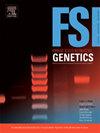The effect of commonly employed forensic DNA extraction protocols on ssDNA/dsDNA proportion and DNA integrity
IF 3.1
2区 医学
Q2 GENETICS & HEREDITY
引用次数: 0
Abstract
The utilisation of massively parallel sequencing (MPS) in forensic DNA analysis is on the rise, driven by the expansion of targeted MPS panels in the market and the introduction of forensic investigative genetic genealogy. The MPS library preparation process, integral to both whole-genome sequencing (WGS) and targeted MPS panel data generation, is largely based on converting double-stranded DNA (dsDNA) into sequencing libraries. In the current study, we examined the effect of seven routinely used forensic DNA extraction methods on the strandedness (single-stranded or double-stranded) and the fragment size of the DNA extracted from buccal swab, blood, bone and tooth samples. Our findings reveal a variation in the proportion of dsDNA and single-stranded DNA (ssDNA), with the phenol-chloroform and silica column-based extraction methods tested predominantly yielding dsDNA, while the tested Chelex and magnetic bead-based extraction methods predominantly yielded ssDNA. Additionally, fragment size analysis showed that high molecular weight dsDNA was recovered from buccal swab samples with all of the extraction methods except Chelex, which yielded relatively short dsDNA fragments. DNA extracted from tooth samples with tested magnetic bead-based extraction methods resulted in longer dsDNA fragments compared to the silica column-based extraction protocol.
常用的法医DNA提取方案对ssDNA/dsDNA比例和DNA完整性的影响。
大规模平行测序(MPS)在法医DNA分析中的应用正在上升,这是由市场上目标MPS面板的扩展和法医调查基因谱系的引入所驱动的。MPS文库制备过程是全基因组测序(WGS)和靶向MPS面板数据生成的组成部分,主要基于将双链DNA (dsDNA)转化为测序文库。在目前的研究中,我们研究了七种常规的法医DNA提取方法对从口腔拭子、血液、骨骼和牙齿样本中提取的DNA的链结性(单链或双链)和片段大小的影响。我们的研究结果揭示了dsDNA和单链DNA (ssDNA)比例的变化,以苯酚-氯甲烷和二氧化硅柱为基础的提取方法主要产生dsDNA,而以Chelex和磁珠为基础的提取方法主要产生ssDNA。此外,片段大小分析表明,除Chelex提取方法提取的dsDNA片段相对较短外,所有提取方法都能从口腔拭子样品中提取到高分子量的dsDNA。与基于二氧化硅柱的提取方案相比,采用基于磁珠的提取方法从牙齿样本中提取DNA可获得更长的dsDNA片段。
本文章由计算机程序翻译,如有差异,请以英文原文为准。
求助全文
约1分钟内获得全文
求助全文
来源期刊
CiteScore
7.50
自引率
32.30%
发文量
132
审稿时长
11.3 weeks
期刊介绍:
Forensic Science International: Genetics is the premier journal in the field of Forensic Genetics. This branch of Forensic Science can be defined as the application of genetics to human and non-human material (in the sense of a science with the purpose of studying inherited characteristics for the analysis of inter- and intra-specific variations in populations) for the resolution of legal conflicts.
The scope of the journal includes:
Forensic applications of human polymorphism.
Testing of paternity and other family relationships, immigration cases, typing of biological stains and tissues from criminal casework, identification of human remains by DNA testing methodologies.
Description of human polymorphisms of forensic interest, with special interest in DNA polymorphisms.
Autosomal DNA polymorphisms, mini- and microsatellites (or short tandem repeats, STRs), single nucleotide polymorphisms (SNPs), X and Y chromosome polymorphisms, mtDNA polymorphisms, and any other type of DNA variation with potential forensic applications.
Non-human DNA polymorphisms for crime scene investigation.
Population genetics of human polymorphisms of forensic interest.
Population data, especially from DNA polymorphisms of interest for the solution of forensic problems.
DNA typing methodologies and strategies.
Biostatistical methods in forensic genetics.
Evaluation of DNA evidence in forensic problems (such as paternity or immigration cases, criminal casework, identification), classical and new statistical approaches.
Standards in forensic genetics.
Recommendations of regulatory bodies concerning methods, markers, interpretation or strategies or proposals for procedural or technical standards.
Quality control.
Quality control and quality assurance strategies, proficiency testing for DNA typing methodologies.
Criminal DNA databases.
Technical, legal and statistical issues.
General ethical and legal issues related to forensic genetics.

 求助内容:
求助内容: 应助结果提醒方式:
应助结果提醒方式:


